![]()
![]()
![]()
Use LEFT and RIGHT arrow keys to navigate between flashcards;
Use UP and DOWN arrow keys to flip the card;
H to show hint;
A reads text to speech;
17 Cards in this Set
- Front
- Back
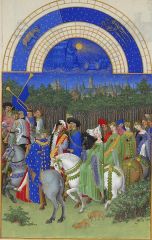
|
May, from Les Tres Riches Heures du Duc de Berry
artist: Limbourg Brothers period: Northern European Renaissance date: 1413-1416 • produced for the Duke of Berry • expensive, treasured • Book of Hours = a kind of almanac • shows idealized pastoral scenes • materials = egg tempera on vellum |
|
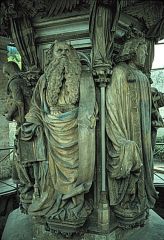
|
Well of Moses
artist: Claus Sluter period: Northern European Renaissance date: 1395-1406 • commissioned by the Duke of Burgundy for Carthusian monastery • truly a well – the water source for the monastery • figures are life size • six figures on the bottom are all old Testament prophets • a crucifixion group was on top of the pedestal but it was smashed in French Revolution • exceptional because of individualized features and expressions |
|

|
Escorial Deposition
artist: Rogier van der Weyden period: Northern European Renaissance date: 1435 • laid out like a medieval mystery play • each figure reacting with a different emotion • other artists studied work because of the high emotion • uses glazing technique to get vivid colors |
|
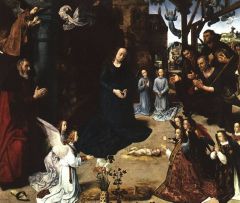
|
Portinari Altarpiece
artist: Hugo van der Goes period: Northern European Renaissance date: 1476 • Done by a northern European artist for a Florentine patron. • The donors – the Portinari family – shown at right and left • indicates their atonement for sin of usury since they were bankers • also a status marker – showed their wealth and position. Highly symbolic portrayal of the adoration. Symbolism includes: • iris & columbine flowers = sorrows of the Virgin • sheaf of wheat = Bethlehem which means “house of bread” in Hebrew • wheat and grape vines on vase = the bread & wine of the Eucharist • harp of house of David on building in background – like tree of Jesse, indicating Jesus had royal ancestors |
|
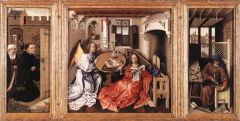
|
Merode Altarpiece
artist: Robert Campin (?) period: Northern European Renaissance date: 1425-1428 • by the Master of Flemalle – possibly Robert Campin • annunciation takes place in the interior of typical middle class Flemish home • highly developed iconography • one side panel shows the donors • other side panel shows Joseph making mousetraps w/realistic cityscape in background |
|
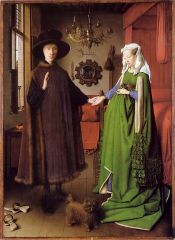
|
Arnolfini Wedding Portrait
artist: Jan van Eyck period: Northern European Renaissance date: 1434 • intended as a legal document; painter acts as witness to betrothal • alliance between two powerful Italian banking families • again, highly developed iconography |
|
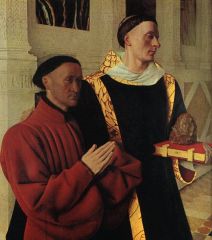
|
Etienne Chevalier & St. Stephen
artist: Jean Fouquet period: Northern European Renaissance date: 1450 • patron with his patron saint • saint is holding the instrument of death (a rock) • half of a diptych; other side shows King’s mistress as Virgin Mary |
|
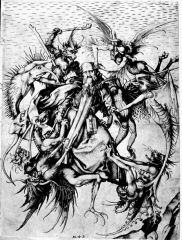
|
St. Anthony Tormented by Demons
artist: Martin Schongauer period: Northern European Renaissance date: 1480-1490 • an engraving – one of the earliest to master technique • shows saint being tormented by demons |
|
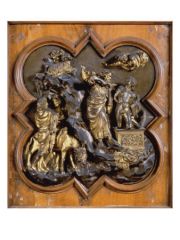
|
Sacrifice of Isaac
artist: Ghiberti period: Renaissance date: 1401-2 • one of two finalists in the contest for the Baptistery doors in Florence • This panel (Ghiberti’s) won because it was more conservative than Brunelleschi’s • the moment is not as emotionally realistic • the lines are more graceful and smooth (conforming to Int’l Gothic Style) |
|
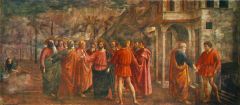
|
Tribute Money
artist: Masaccio period: Renaissance date: 1427 • Made for a private chapel commissioned by merchant-banker (Brancacci) • may be a reference to the castato, the newly instituted income tax in Florence • Shows three different narrative moments in the same space Features that mark it as a Renaissance painting include: • modeling of figures • sense that real bodies are under draperies • articulated movement • grouping of figures to give illusion of depth (in a circle around Christ) • care with perspective • use of light, striking figures at an angle, producing shadows = chiaroscuro • chiaroscuro used to give depth • substance and solidity of the building – not a necessary element but used to give a point for the display of perspective • atmospheric perspective in mountains in background |
|
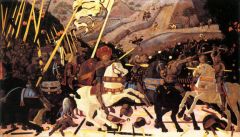
|
Battle of San Romano
artist: Paolo Uccello period: Renaissance date: 1455 • Commissioned by Cosimo di Medici • includes flattering references to the Medici, esp. orange trees • Commemorates a battle between Florence and Siena. • Shows Uccello’s obsession with perspective, including: • foreshortening of figures, horses, objects in foreground • careful organization of figures, objects and shadows designed to lead eye into deep space • pattern formed by repetition of shapes on the ground forming a grid at an attempt at orthogonals, although they are inaccurate |
|
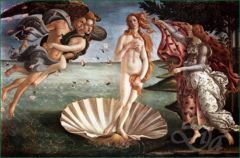
|
Birth of Venus
artist: Botticelli period: Renaissance date: 1482 • Botticelli uses a classical goddess to represent a Neo-Platonic concept • represents “first” nude female figure since antiquity • Venus probably modeled on a classical statue • Commissioned for 14-year-old Medici cousin • intended for private consumption only – this is NOT public art. |
|
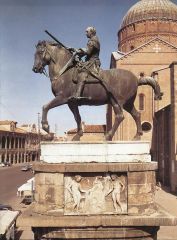
|
Gattamelata
artist: Donatello period: Renaissance date: 1445-1450 • commissioned by Venetian republic to honor mercenary general • modeled on Roman equestrian statue like Marcus Aurelius • shows the bearing of a commander • proportions of man and horse are equivalent • horse’s hoof is resting on a cannonball |
|

|
Madonna and Child with Angels
artist: Fra Filippo Lippi period: Renaissance date: 1455 • shows linear technique; disegno • celebration of feminine beauty • model might be his mistress |
|
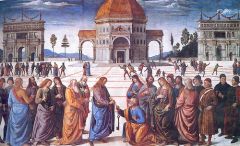
|
Christ Delivering the Keys of the Kingdom to Saint Peter
artist: Perugino period: Renaissance date: 1481-1483 • A fresco on the wall of the Sistine Chapel • Reaffirms papal authority and power • shows Christ giving the keys to his kingdom to St. Peter (succeeded by the popes) •Painting seems to give more attention to experimentation in perspective and careful rendering of the Roman-looking buildings in the background than narrative |
|
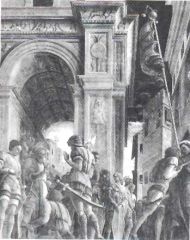
|
Saint James Led to Martyrdom
artist: Mantegna period: Renaissance date: 1455 • A fresco, largely destroyed by World War II • shows three key aspects of Mantegna’s art and his role as a key Renaissance painter • renders historical details accurately, like the Roman uniforms • renders the architectural details—note coffered barrel vault of the arch • experiments with perspective and foreshortening Mantegna only seemed secondarily interested in the narrative, which shows Saint James pausing to bless a man as he himself is being led to his own death. |
|
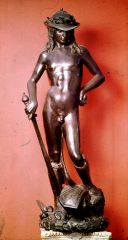
|
David
artist: Donatello period: Renaissance date: 1428-1432 • first free-standing nude statue since the Classical era • problematic because the figure is so androgynous. • commissioned by the Medici as o art – for viewing inside their palazzo. |

